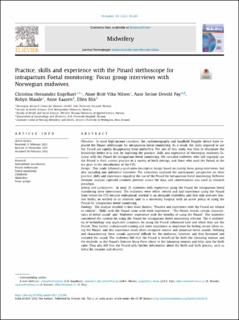| dc.contributor.author | Engelhart, Christina Hernandez | |
| dc.contributor.author | Nilsen, Anne Britt Vika | |
| dc.contributor.author | Pay, Aase Serine Devold | |
| dc.contributor.author | Maude, Robyn | |
| dc.contributor.author | Kaasen, Anne | |
| dc.contributor.author | Blix, Ellen | |
| dc.date.accessioned | 2022-09-09T11:42:49Z | |
| dc.date.available | 2022-09-09T11:42:49Z | |
| dc.date.created | 2022-03-09T13:28:07Z | |
| dc.date.issued | 2022 | |
| dc.identifier.citation | Engelhart, C. H., Nilsen, A. B. V., Pay, A. S. D., Maude, R., Kaasen, A., & Blix, E. (2022). Practice, skills and experience with the Pinard stethoscope for intrapartum Foetal monitoring: Focus group interviews with Norwegian midwives. Midwifery, 108. | en_US |
| dc.identifier.issn | 0266-6138 | |
| dc.identifier.uri | https://hdl.handle.net/11250/3016895 | |
| dc.description.abstract | Objective
In most high-income countries, the cardiotocography and handheld Doppler device have replaced the Pinard stethoscope for intrapartum foetal monitoring. As a result, the skills required to use the Pinard are rapidly disappearing from midwifery. The aim of this study was thus to illuminate the knowledge before it is lost, by exploring the practice, skills and experience of Norwegian midwives familiar with the Pinard for intrapartum foetal monitoring. We included midwives who still regularly use the Pinard in their current practice in a variety of birth settings, and those who used the Pinard in the era prior to the introduction of the CTG.
Design
This study followed a qualitative descriptive design based on mainly focus group interviews, but also including one individual interview. The interviews explored the participants` perspective on their practice, skills and experience regarding the use of the Pinard for intrapartum foetal monitoring. Reflexive thematic analysis captured common patterns across the data, and contextualism was used as research paradigm.
Setting and participants
In total, 21 midwives with experience using the Pinard for intrapartum foetal monitoring were interviewed. The midwives were either retired and had experience using the Pinard from before the CTG became widespread; worked in an alongside midwifery unit that only oversees low-risk births; or worked in an obstetric unit in a university hospital with an active policy of using the Pinard for intrapartum foetal monitoring.
Findings
The analysis resulted in four main themes: “Practice and experience with the Pinard are related to context”, “Skills with the Pinard come with work experience”, “The Pinard reveals certain characteristics of foetal sound” and “Midwives` experience with the benefits of using the Pinard”. The midwives considered the context for using the Pinard for intrapartum foetal monitoring relevant. The e availability of technology and applicable situations for using the Pinard influenced how and when they use the Pinard. They further underpinned training and work experience as important for feeling secure when using the Pinard, and this experience made them recognize normal and abnormal foetal sounds. Defining and characterizing these sounds appeared difficult for the midwives, however, and they hesitated and imitated the sound. The midwives felt that the Pinard is beneficial for both the labouring woman and the midwife, as the Pinard's features bring them closer to the labouring woman and help calm the birth suite. They also felt that the Pinard adds further information about the birth and birth process, such as foetal lie, rotation and descent.
Keyconclusions
Norwegian midwives’ practice, and experiences in using the Pinard for intrapartum foetal monitoring are connected to context as technological development and applicable situations. The midwives explained that knowledge obtained through experience gives them skills to differentiate between normal and abnormal foetal sound characteristics, though they found it difficult to define the characteristics themselves. Using the Pinard stethoscope during birth calms the birth suite and brings the midwife closer to the labouring woman. | en_US |
| dc.language.iso | eng | en_US |
| dc.publisher | Elsevier | en_US |
| dc.rights | Navngivelse 4.0 Internasjonal | * |
| dc.rights.uri | http://creativecommons.org/licenses/by/4.0/deed.no | * |
| dc.subject | intermittent auscultation | en_US |
| dc.subject | Pinard stethoscope | en_US |
| dc.subject | foetal monitoring | en_US |
| dc.subject | childbirth | en_US |
| dc.subject | midwifery | en_US |
| dc.subject | focus groups | en_US |
| dc.title | Practice, skills and experience with the Pinard stethoscope for intrapartum Foetal monitoring: Focus group interviews with Norwegian midwives | en_US |
| dc.type | Peer reviewed | en_US |
| dc.type | Journal article | en_US |
| dc.description.version | publishedVersion | en_US |
| dc.rights.holder | © 2022 The Authors | en_US |
| dc.source.volume | 108 | en_US |
| dc.source.journal | Midwifery | en_US |
| dc.identifier.doi | 10.1016/j.midw.2022.103288 | |
| dc.identifier.cristin | 2008533 | |
| cristin.ispublished | true | |
| cristin.fulltext | original | |
| cristin.qualitycode | 1 | |

